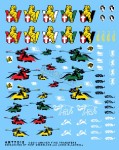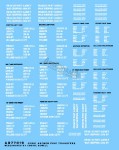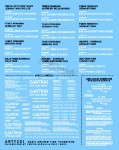Saturday, January 21, 2012 - 04:33 AM UTC
Archer Fine Transfer Continue to expand their range of aftermarket decals for our models, and something else besides. This month they have also released a new guide on using their line of “Human Eye” decals. Take a look inside for details.
Here are the new products from Archer Fine Transfer.
• AR77018 - Tiger battalion insignias - Researched by Tony Greenland and James Blackwell - €7.95
WATERSLIDE DECALS
Includes a generous supply of insignias for sPzAbt 501, 502, 503, 505 (3 sizes), 506, 507, 509 and 510. Includes instructions.
• AR77019 - U.S. D-Day shipping stencils for Halftracks, GMC's and armor other than Sherman’s - Researched by Cookie Sewell - €6.95
WATERSLIDE DECALS
These stencil markings were applied to both sides of of vehicles for dock handlers to find, record and compute the data for loading onto tactical transport vehicles. Lettering in scale 1 1/2 inch and 3/4 inch.
Includes shipping stencils in two different sizes for a T26E3 Pershing Heavy Tanks; M5A1 Stuart Light Tanks; M24 Chaffee Light Tanks; M2, 3 or 4 Halftracks; M18 76 mm Tank destroyers and M7 105 mm GMC Priests. Includes instructions.
• AR77020 - U.S. D-Day shipping stencils for Shermans - Researched by Cookie Sewell - €6.95
WATERSLIDE DECALS
These stencil markings were applied to both sides of of vehicles for dock handlers to find, record and compute the data for loading onto tactical transport vehicles. Lettering in scale 1 1/2 inch and 3/4 inch.
Includes shipping stencils in two different sizes for an M4 (early), M4A3 (early) or M4A3 75mm (late), M4A1 (early), M4A1 (late), M4A3E8, M4A2 and M4A4 Sherman tanks. Includes instructions.
• AR77021 - U.S. late WWII address codes, miscellaneous stencils and hull stencils for Lend-Lease Sherman’s in Russian service - Researched by Cookie Sewell and Nick Tebbs - €6.95
WATERSLIDE DECALS
In order to facilitate pinpoint deliveries of high priority war goods, in 1944 the US instituted a coding system that was used to send goods that supported US forces deployed overseas. These were made complex due to the number of customers needing support, as well as the detail required for pinpoint shipments.
Also, as vehicles had to proceed through ordnance processing checkpoints, data was added to the outside of the vehicle to tell the consumer (receiving unit) what and when a specific process had taken place. These included radio installation and checks, winterization, and other things which were necessary for safe operation of the vehicle. One of the most common was the stencil "CAUTION LEFT HAND DRIVE" and "NO SIGNALS" on vehicles in the United Kingdom to warn motorists that the vehicle would not behave like a British vehicle with right hand drive.
Includes multiple late WWII shipping address codes for an M4 Sherman "Aunt Jemima" Mine Roller; T26E3 to Germany, Okinawa and Belgium; M4A3 76mm Sherman to Italy; M4A3E2 Jumbo Sherman to Bastogne; M4A3E8 Sherman to Germany and M36 90mm GMC to Austria. Other shipping address codes can be created by cutting and splicing codes to match your reference material. Sheet also includes a wide variety of U.S. WWII miscellaneous stenciled data and bonus hull stenciling for one Lend-Lease Sherman in Russian service. Includes instructions.
• The Human Eye Instructions
The illustration above shows the appearance of a human eye under average lighting conditions. Notice that the iris occupies half the width of the visible eyeball and is partially covered at the top, and to a lessor degree at the bottom by the eyelids. Trim the decal to achieve this appearance. The only time you will want to see the entire iris is when your figure's expression is one of shock.
Before applying eye decals you should completely paint the "whites" of the eyes including any shading or washes used to accent the lines between the eyeball and eyelids. Note in the illustration that the eyeball should be shaded in the corners to avoid a "pop-eye" effect. The only part of the eye that should be pure white is where the decal will go.
After you have removed the decals you want from the sheet trim the top and bottom and one side leaving a little extra for a "handle" on the other side. The decals are printed on a continuous clear film. Use a hemostat or tweezers to grasp the handle and score through the clear film on the handle side of the eye decal. This will allow the iris to separate from the handle side when moistened.
Apply them the same as you would any decal. It is best to moisten the kit eyeball with Micro-Set first to improve their adhesion. Once they are completely dry, a small drop of Micro-Sol setting solution can be applied to insure that they conform to the kit. Once dry they may be coated with either a gloss acrylic clear or Future floor wax. A thick layer of solvent based clear could ruin the eyes.
• AR77018 - Tiger battalion insignias - Researched by Tony Greenland and James Blackwell - €7.95
WATERSLIDE DECALS
Includes a generous supply of insignias for sPzAbt 501, 502, 503, 505 (3 sizes), 506, 507, 509 and 510. Includes instructions.
• AR77019 - U.S. D-Day shipping stencils for Halftracks, GMC's and armor other than Sherman’s - Researched by Cookie Sewell - €6.95
WATERSLIDE DECALS
These stencil markings were applied to both sides of of vehicles for dock handlers to find, record and compute the data for loading onto tactical transport vehicles. Lettering in scale 1 1/2 inch and 3/4 inch.
Includes shipping stencils in two different sizes for a T26E3 Pershing Heavy Tanks; M5A1 Stuart Light Tanks; M24 Chaffee Light Tanks; M2, 3 or 4 Halftracks; M18 76 mm Tank destroyers and M7 105 mm GMC Priests. Includes instructions.
• AR77020 - U.S. D-Day shipping stencils for Shermans - Researched by Cookie Sewell - €6.95
WATERSLIDE DECALS
These stencil markings were applied to both sides of of vehicles for dock handlers to find, record and compute the data for loading onto tactical transport vehicles. Lettering in scale 1 1/2 inch and 3/4 inch.
Includes shipping stencils in two different sizes for an M4 (early), M4A3 (early) or M4A3 75mm (late), M4A1 (early), M4A1 (late), M4A3E8, M4A2 and M4A4 Sherman tanks. Includes instructions.
• AR77021 - U.S. late WWII address codes, miscellaneous stencils and hull stencils for Lend-Lease Sherman’s in Russian service - Researched by Cookie Sewell and Nick Tebbs - €6.95
WATERSLIDE DECALS
In order to facilitate pinpoint deliveries of high priority war goods, in 1944 the US instituted a coding system that was used to send goods that supported US forces deployed overseas. These were made complex due to the number of customers needing support, as well as the detail required for pinpoint shipments.
Also, as vehicles had to proceed through ordnance processing checkpoints, data was added to the outside of the vehicle to tell the consumer (receiving unit) what and when a specific process had taken place. These included radio installation and checks, winterization, and other things which were necessary for safe operation of the vehicle. One of the most common was the stencil "CAUTION LEFT HAND DRIVE" and "NO SIGNALS" on vehicles in the United Kingdom to warn motorists that the vehicle would not behave like a British vehicle with right hand drive.
Includes multiple late WWII shipping address codes for an M4 Sherman "Aunt Jemima" Mine Roller; T26E3 to Germany, Okinawa and Belgium; M4A3 76mm Sherman to Italy; M4A3E2 Jumbo Sherman to Bastogne; M4A3E8 Sherman to Germany and M36 90mm GMC to Austria. Other shipping address codes can be created by cutting and splicing codes to match your reference material. Sheet also includes a wide variety of U.S. WWII miscellaneous stenciled data and bonus hull stenciling for one Lend-Lease Sherman in Russian service. Includes instructions.
• The Human Eye Instructions
The illustration above shows the appearance of a human eye under average lighting conditions. Notice that the iris occupies half the width of the visible eyeball and is partially covered at the top, and to a lessor degree at the bottom by the eyelids. Trim the decal to achieve this appearance. The only time you will want to see the entire iris is when your figure's expression is one of shock.
Before applying eye decals you should completely paint the "whites" of the eyes including any shading or washes used to accent the lines between the eyeball and eyelids. Note in the illustration that the eyeball should be shaded in the corners to avoid a "pop-eye" effect. The only part of the eye that should be pure white is where the decal will go.
After you have removed the decals you want from the sheet trim the top and bottom and one side leaving a little extra for a "handle" on the other side. The decals are printed on a continuous clear film. Use a hemostat or tweezers to grasp the handle and score through the clear film on the handle side of the eye decal. This will allow the iris to separate from the handle side when moistened.
Apply them the same as you would any decal. It is best to moisten the kit eyeball with Micro-Set first to improve their adhesion. Once they are completely dry, a small drop of Micro-Sol setting solution can be applied to insure that they conform to the kit. Once dry they may be coated with either a gloss acrylic clear or Future floor wax. A thick layer of solvent based clear could ruin the eyes.
Click Star to Rate
2 readers have rated this story.
THIS STORY HAS BEEN READ 7,853 TIMES.
| Archer Fine Transfers Reviews | MORE |
| Propaganda Posters by Bill Cross | |
| Rivets in a Circular Pattern by Frederick Boucher | of 1 ratings, 100% found this helpful | |
| UK Indy Armoured Brigade Signs by Bill Cross | |
| UK & Commonwealth AOS Signs by Bill Cross | |
| US Army and Corps Patches 2 by Bill Cross | |
| US Army Patches Set 1 by Bill Cross | |
| D-Day Shipping Stencils by Bill Cross | |
| German Road Signs by Bill Cross | |
| Citroen Instruments by Gino P. Quintiliani | |
| Jeep Instruments by Gino P. Quintiliani | |
| Simca and Bussing Instruments by Kevin Brant | |
| WWII Ambulance Markings by Kevin Brant | |
| UK & Commonwealth Placards by Bill Cross | |
| Citroën instruments by Mario Krajinovic | of 1 ratings, 100% found this helpful | |
| German 75mm ammo stencils by Mario Krajinovic | of 3 ratings, 100% found this helpful | |














Comments